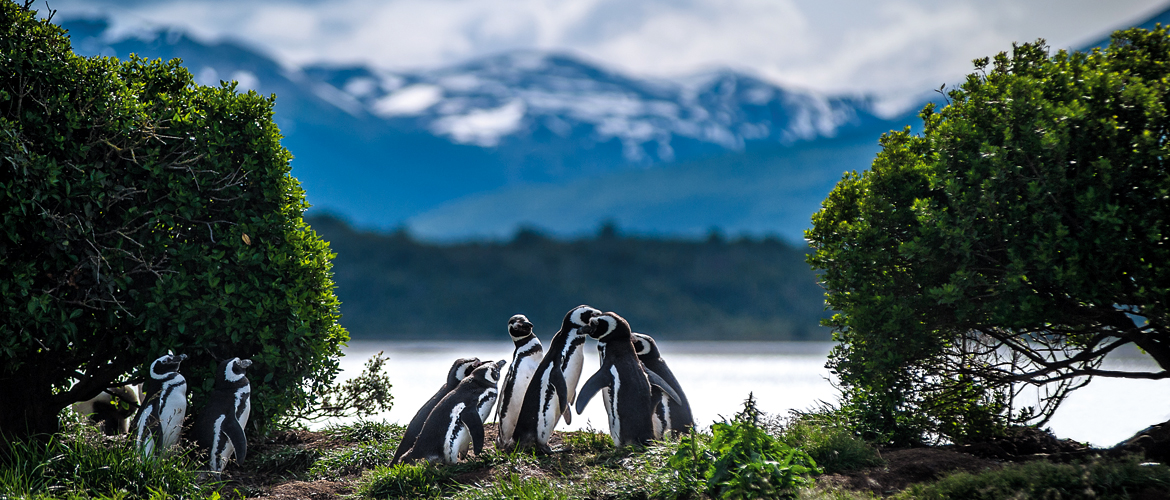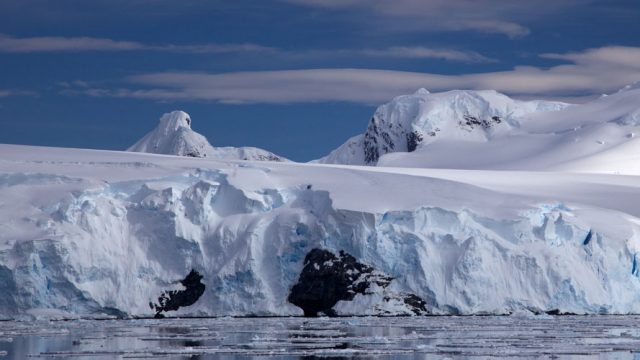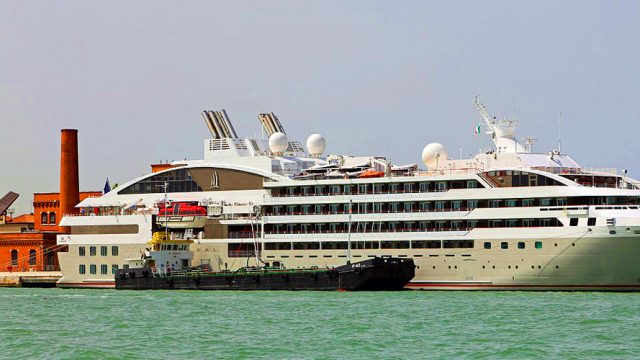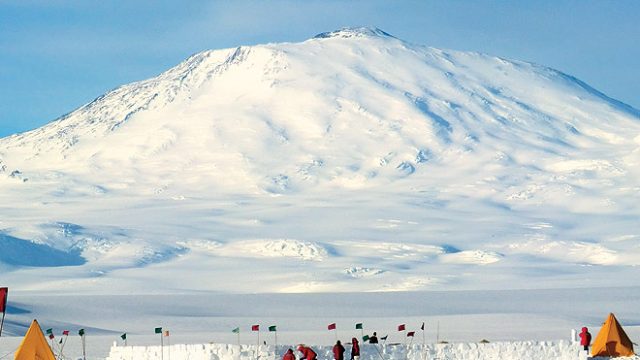Antarctica is stranger and more beautiful than I imagined. It is a million shades of blue. Jagged,

It is hard to be distracted by anything. For ten days, I covered considerable ground on my voyage with Antarpply Expeditions. Beginning in the frontier town of Ushuaia in Tierra del Fuego (Land of Fire), known as El Fin del Mundo (The End of the World) and the southernmost settlement on Earth, we sail along the Beagle Passage, named after the ship that Charles Darwin took on his famous voyage. The next day, orcas and snow petrels follow the Francis Drake Passage, called the roughest sea in the world, and for good reason. Millions of cubic metres of water drives through the Passage every second, the equivalent of 6,000 odd Amazon rivers. A massive confluence of water where the Atlantic, Pacific, and Southern Oceans clash, the Drake Passage is a violent eruption of sub-polar and polar waters that have historically jostled boats to near devastation. On the second day, I awake to the sound of dull metallic thuds ringing through the cabin, with a sudden roll and drop of the entire room. I stumble out of bed, grab my jacket and run to the front of the ship. The winds howl and I know that we have been hit by a massive storm. Waves pound the front of the ship and spray wildly while I hastily retreat indoors. The storm is so violent, that anxious crew members do a drill and come banging on all cabin doors to ensure that the passengers are safe. Incidentally the ship has no staircases, only ladders to climb up to your cabin and ladders to come down to the dining room for meals. A bit of discipline is needed here, for meal times are strictly adhered to and eating round the clock is not a possibility. The tables and chairs are all firmly fixed, so you can eat comfortably, despite the rocking.

It’s a two-day crossing and the Drake lives up to its fame. During the storm, the decks and exteriors of our ship, the Ushuaia, are covered with sleet and snow, ropes cordon off the deck areas and no one dares to venture outside. The ship’s crew recommend we have our meals and go to sleep. I prefer to be in the eye of the storm, sitting in the lounge, heart in my mouth, feeling the crash of the waves with winds blowing at 50 to 80 knots. I will never forget the snowstorm in the passage. The ship is equipped with safety railings almost throughout, for balancing in tricky situations. But when I turn around, I see our Argentinian bartender balancing a bottle and six wine glasses on the tray! He tells us that being sea sick comes from a confusion in your brain. Things that possibly help the situation are bitter orange marmalade, quinine, smoking opium like in the old days, or just getting dead drunk. I choose none of these, and prefer to enjoy the violent crashing of the waves, the roll and drop of the ocean, though I do admit that my stomach lurches with the tension and anxious moments. I am, after all, in the thick of the world’s most treacherous ocean passages.


After crossing the Drake Passage, a series of zodiac cruises ensue. I discover seals napping on icebergs, albatrosses and snow petrels soaring above glaciers, and thousands of penguins marching up slopes. I spot penguin highways, paths created by penguins walking up and down, skidding and slipping on the ice very often. The naturalist tells us that infidelity and divorce are common. I watch the Adelie penguins struggle to jump on to the ice. They have a competitive spirit, so the push and shoves are there, as they clamber up the sharp edges to reach safe ground, away from aggressive sea lions. During the course of the voyage we see colonies and bunches of Chinstrap penguins and Gentoo as well. Often we walk very close to a penguin colony where the calls and responses of parents and chicks are occasionally outdone by the belching of huge elephant seals lazily strewn along the kelp-covered sandy beach. The penguins feed on fish, krill and squid. Here we learn about the ‘nunataks’, rocky mountaintops sans ice/snow. These are slippery edges where vegetation survives—things like lichens, moss, algae and some flowering plants. Then there is kelp, the largest marine plant, with a growth rate of 60 centimetres a day, clinging to the shoreline. Seals wrap their babies in kelp to ward off seagulls and other predators. There are only two flowering plants in Antarctica—a hair grass that tolerates freezing point and the pearlwort, a weed with tiny open flowers. It’s a miracle that plants grow in Antarctica, so I walk carefully and ensure that I do not tread on them.
While the flora and fauna fascinate me, I’m drawn to the icebergs. Bobbing to the ocean’s beat, both strong and fragile, climate is their only opposition. Manoeuvring the sheets of brash ice, we navigate straits and channels in the Antarctic wilds, our ship changing course due to icebergs, wildlife sightings, and ice sheets. Reaching the Weddell Sea and later through the Antarctic Sound, I see why this area is known as a parking lot for giant icebergs: this is where huge tabular icebergs roam. Sometimes this area is full of ice, making for exciting navigation. The icebergs are startlingly huge, massive buildings and football fields of ice.

I get up early and go out on the deck. It’s four in the morning. I look around for the sunrise, but the sky is already bright blue and clear when the huge tabular bergs break from the Larsen, Ronne, and Filchner ice shelves and combine with young and not-so-young sea ice to produce a floating, undulating panorama of rugged, frozen scenery. It is difficult to imagine the experience of moving around thousands of icebergs teeming with seals, penguins, whales and even the most dangerous predator in Antarctica—the leopard seal. They are difficult to spot; since they spend a majority of their time underwater in the austral summer. When we spot a leopard seal napping on an iceberg, our zodiac guide turns off its motor to get a better look without disturbing it. Our Antarctic adventures start to get even more exciting. I know that the rest of the day will be great when I wake up to the mirror image of snowcapped mountains reflecting in the calm waters of an area aptly named Paradise Bay. We set out on another zodiac cruise around the bay with penguins, birds and the usual ice and scenery for company. Suddenly, we spot a Minke whale swimming close by. This is actually not exceptional for Antarctica. I see many in a single day in Danco Island and Wilhelmina Bay. That is pretty much a typical day, or the closest thing you can get to one in Antarctica.
Ushuaia’s open bridge policy allows us to join the captain and his mates and learn about navigation, watch whales, and enjoy the view. We are treated to lectures on numerous topics—density of chlorophyll to determine where seabirds are nesting, how scientists resurrect moss and algae over a hundred years old, and ice shelf formation among others. I realise that when in Antarctica, you never refuse anything! There is a humpback whale on the starboard side. Get up from your bed, run up and go see it, because it could be the best sight of your life. Feeling tired and lazy in the afternoon? Don’t skip the zodiac excursion, because that is the time your fellow passengers may witness a caving iceberg. Feeling cold and want to go back to the warm ship? Climb to the top of the hill anyway. Antarctica is not a place to choose the easier option. When I get to the deck, I fill my lungs with glacial air and wipe my streaming eyes. The sea is dead calm, and I notice the ship has sailed farther away from the icebergs. I find myself feeling utterly alone, thinking of how little space I occupy within Antarctica’s mass. I thought I would come back from Antarctica saying that now I have been to all seven continents. But it’s nothing like that. And the Polar Plunge? I admit that I had no desire to jump into the icy waters, but to my surprise there are many who do so. They jump in and come running out of the waters to join a couple of penguins who are strolling at the water’s edge!
What an adventure! Steeped in the legacy of the polar exploration pioneers and rich in the wildness of a place far removed from the ravages of humans, I have been privileged to set foot in Antarctica. No, I’m not ticking it off. It is the last truly wild and pristine continent, untouched by mankind. And once I have let it into my heart, it will undoubtedly summon me again.
The Information
Getting There
You can fly via British Airways (approx. ₹1.5 lakh round trip) or Ethiopian Airlines (approx. ₹1 lakh round trip) to reach Buenos Aires, the capital of Argentina. Fly LATAM Airlines (approx. ₹17,500 round trip) internally to reach Ushuaia to begin the cruise.
Visa
An Argentina visa is required. Though the visa is free of cost, all the documents to be submitted have to be translated to Spanish.
The Cruise
>MV Plancius and MV Ushuaia are recommended.
>The cost is approx. ₹6,00,000 and above, depending on the vessel and cabin category you decide on.
>Most excursions and on-shore activities are provided by the ship but you can choose to camp, polar dive, kayak, etc. (Again depending on availability.)
Tips
>Temperatures vary vastly across the continent, but summer (January to March) is the best time to go.
>Carry essentials like a warm parka, insulated waterproof boots, waterproof pants, several pairs of warm socks, woollen base layers to stay warm, hat, scarf and gloves, seasickness medication, binoculars, sunglasses, sunblock, and a camera.
>If you have any health problems, it’s best to consult your doctor prior to booking your trip. Small problems can sometimes turn into larger ones due to the harsh conditions. It is also worth checking that your travel insurance company covers you for any pre-existing medical conditions on your trip.
International
wildlife
travel





